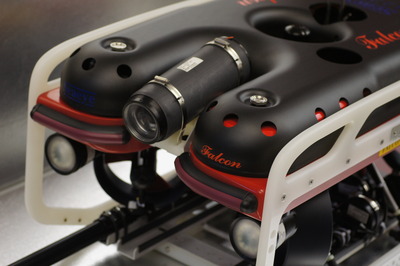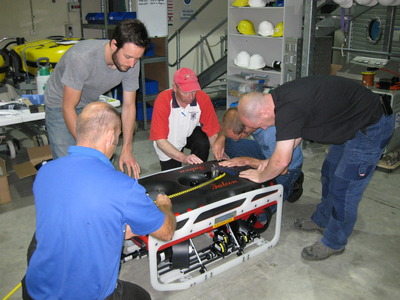ROV aids critical Antarctic krill research
Wednesday, 18 July, 2012
A specially modified Falcon remote-operated vehicle has been supplied by ATSA Defence Services to the Antarctic Climate and Ecosystems Cooperative Research Centre (ACE CRC) for research into sea ice algae. The vehicle will be jointly operated by researchers from ACE CRC and the Australian Antarctic Division (AAD).

ACE CRC says new methods and technologies are needed to answer the questions of how the winter sea-ice extent affects biological productivity off East Antarctica and how sensitive krill populations are to potential future changes in sea ice extent. The centre selected the Falcon ROV for this critical work for a number of operational reasons, including the ease of removing ice from its propellers.
To meet the research specifications required, the ROV carries a special black finish, single-function, three-jaw manipulator arm and a fibre-optic upgrade to accept additional sensors. The ATSA engineering team spent four days training ACE CRC and AAD staff in the fibre-optic system, as well as monitoring the Falcon’s performance in ATSA’s test tank.

During the Sea Ice Physics and Ecosystem eXperiment II (SIPEX II) the researchers will use newly developed sampling and observing systems and technologies to address their questions. These include the Falcon ROV, instrumented with an upward-looking sonar, light sensors and camera systems, to observe the subsurface of sea ice floes and film krill under sea ice.
The ROV will be piloted from a control stand within a laboratory container on board the Aurora Australis, while a small crew operates its 350 m-long tether at a drill-hole out on the ice floe. Using online sonar data, the ROV will be ‘flown’ at a known distance to the subsurface of the ice, and while video observations are performed, measurements of the under-ice light field will be taken. These optical measurements are used to estimate the algal biomass within the sea ice.
The method allows the quantification of ice algal biomass along transects and is approximately 20 times faster than classical ice coring methods, saving valuable ship time. Classical ice sampling methods - often based on ice corers with small diameters - provide insufficient data to understand large-scale processes.
Forming a centimetre- to metre-thick skin on the ocean’s surface, sea ice provides a platform for marine birds and mammals and a substrate for microalgae. It is also a habitat for Antarctic krill - a key species in the Southern Ocean food chain - that feed on ice algae during winter and spring, when food in the water column is scarce. The ACE CRC says further research is needed to understand the physical, chemical and biological properties of sea ice during winter and early spring.
European Space Agency inaugurates deep space antenna in WA
The ESA has expanded its capability to communicate with scientific, exploration and space safety...
Black hole collision supports Hawking's landmark theory
Astrophysicists have witnessed a collision between two black holes that was so loud, they were...
Uncovering differences in wild and domesticated crops
Researchers have revealed insights into the genetic make-up of wild varieties of common crops...





